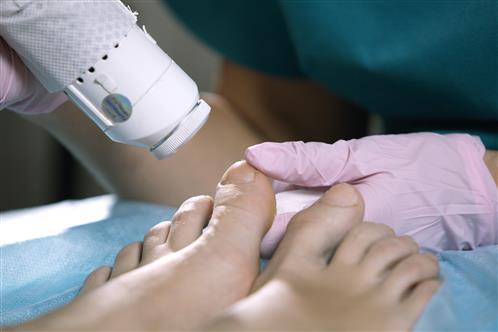Common Nail Infections Easily Treatable
Ingrown toenails and fungal nail infections are among two of the most common foot problems treated by podiatrists. About 18 percent of adults in the U.S. will experience an ingrown toenail at some point in their lives, according to the Institute for Preventative Foot Health, while fungal nail infections will affect about 10 percent of adults.

A large number of ingrown toenails and fungal nail infections go untreated, as many adults do not feel these conditions warrant seeking treatment by a foot doctor. Leaving these conditions untreated is a big mistake, however, as they can cause significant pain and discomfort. Over time, untreated ingrown toenails and fungal nail infections can cause more severe health issues. Fungal nail infections may also be a symptom of serious health problems such as diabetes, cancer, or immune disorders.

While fungal nail infections and ingrown toenails can be resolved without a foot specialist’s intervention, individuals who have either had a problem for more than a few days or who has health conditions such as diabetes, AIDS, or cancer will want to seek treatment. Podiatrists can quickly diagnose these conditions and recommend appropriate care, and they can also help determine whether problems with ingrown toenails or fungal foot infections are indicative of more significant health issues.
Ingrown Toenails
Ingrown toenails can be extremely painful, and particularly if they become infected. This foot condition occurs when a toenail grows into the flesh instead of over it.

Ingrown toenails have a variety of causes. The most frequent cause is wearing ill-fitting shoes or tight hosiery that push the nail into the flesh of the toe. Stubbing or jamming your toe can also cause ingrown toenails, as can cutting your toenails too short. The damp atmosphere in enclosed shoes may also cause ingrown toenails, as doing so may encourage abnormal growth in the toenails.

Home remedies for ingrown toenails include soaking the affected foot in warm epsom salt baths for about 15 minutes two or three times daily, or wedging a small piece of wet cotton under the affected toenail to lift it off the flesh. Should these remedies prove insufficient, or if you have repeated problems with ingrown toenails, seeing a foot doctor is recommended.
Podiatrists have a number of treatments they can use for ingrown toenails. Your foot doctor will likely prescribe antibiotics to treat any infection the ingrown toenail has caused, and you may need surgery to remove the ingrown toenail. Surgery for ingrown toenails is rather straightforward. You’ll be given a local anesthetic, and the surgeon will remove the part of the nail causing the problem. In more severe or recurrent cases of ingrown toenails, the surgeon will remove a larger portion of the nail, and then treat the nail matrix with chemicals to inhibit regrowth. The patient will regrow a smaller, narrower nail.
In extreme cases, a foot surgeon may need to completely remove the nail and treat the nail matrix with phenol to ensure the nail never grows back. Only a very small number of patients ever need a full nail avulsion, however. After a full nail avulsion, and sufficient recovery time, patients can wear fake nails or use nail varnish to create the appearance of a normal nail.
Some podiatrists will treat ingrown toenails with nail braces. These lift the sides of the nail and, over time, guide the nail to grow properly. Doctors may often use this procedure with diabetics, as these patients should avoid surgery whenever possible.
Older people are at elevated risk of developing ingrown toenails. Ingrown toenails also pose a problem for diabetics, as they can cause a significant infection and may lead to gangrene, necessitating amputation. Diabetics with ingrown toenails should immediately seek medical treatment of the condition.
Even among non-diabetics, an ingrown toenail left untreated can result in a serious bone infection, in some cases. Seeing a foot specialist to treat this condition is well worth the time and expense when you consider the possible consequences of an untreated ingrown toenail.
Fungal Nail Infections
Fungal nail infections are the most common type of nail infection and make up about half of all nail abnormalities. These infections are characterized by the toenail becoming thick and discolored. In many cases, the nail will turn white, black, yellow, or green. Over time, the nail may become brittle, causing pieces of it to break off from the toe. Over time, the condition can become painful, as the skin around the nail becomes inflamed, but most of the negative impact of the illness is aesthetic, except in cases where it causes more significant infections.
Age is a significant risk factor for fungal nail infections, as slower growing nails and poor circulation can contribute to the illness. Sweating, humid environments, psoriasis, athlete’s foot, and injuries to the feet or nails can also increase a person’s likelihood of developing a fungal nail infection.
A foot specialist’s expertise is necessary to diagnose fungal nail infections, as the condition is often confused by laypeople with other problems such as psoriasis, yellow nail syndrome, chronic paronychia, and even normal aging..

Foot doctors have a variety of options available to treat fungal nail infections, including medication and partial removal of the nail. The vast majority of treatments involve using topical or oral antifungal medicine. Some of the most commonly used oral medications to treat the condition are terbinafine, itraconazole, and fluconazole. These medications will promptly penetrate the nail and nail bed, and stick around to combat the illness for a significant amount of time after patients stop taking the medication. Most patients have an easier time taking terbinafine than itraconazole.
For topical use, doctors most frequently prescribe ciclopirox nail paint, amorolfine, or efinaconazole. Patients will need to use these treatments on a daily basis for an extended amount of time, typically about a year. Ciclopirox is often prescribed along with terbinafine, as the two appear to work well together.
Unfortunately, even after treatment, recurrence of fungal nail infections is quite common, as up to 50 percent of patients will experience the problem again.
In recent years, podiatrists have begun using lasers to treat the problem. Laser treatment is used to burn away the fungal infection without damaging the nail or surrounding skin. This development is rather new and costly. Studies are being done to evaluate its effectiveness..

A fungal nail infection may be a symptom of a more serious problem like diabetes, HIV, or cancer. Your foot physician can help determine if your fungal nail infection is indicative of a more serious underlying problem, making seeking medical treatment for fungal nail infections a wise decision.
Patients with diabetes or other serious health problems need to take fungal foot infections seriously because of the condition’s likelihood of causing complications. These patients are at increased risk of developing cellulitis, a serious bacterial infection, or osteomyelitis, a bone infection, if their fungal nail infection goes untreated. Both of these illnesses can have severe health consequences, making medical treatment of fungal nail infections absolutely imperative for these patients.
Even if you don’t have one of these illnesses, you should seek medical treatment immediately if the affected area discharges pus, or if there are red streaks around the affected area, as these may be indicators of a bacterial infection. Patients who develop a fever of more than 100.4°F should also seek medical attention.
If you or a friend or family member suffer from an ingrown toenail or fungal nail infection, foot specialist Dr. Sean Ravaei can help. Ravaei, a highly qualified foot specialist, has helped patients throughout Southern California with a variety of foot problems, including ingrown toenails and fungal nail infections. Ravaei works to provide individualized, holistic foot treatment plans to his patients. With Ravaei’s help, patients suffering from a variety of foot issues can get the treatment they need to alleviate pain and resolve any mobility issues the condition may be causing.
Sources:













